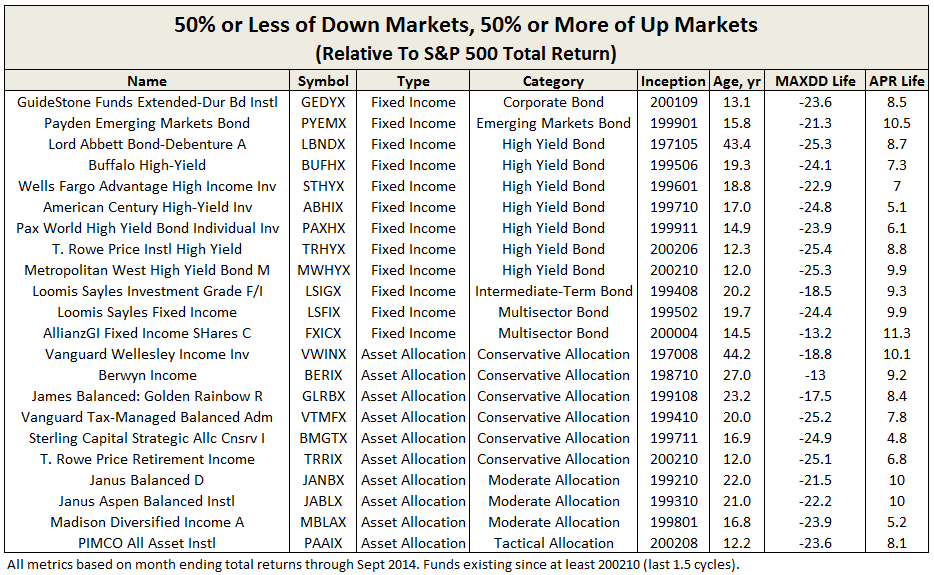Watch Out For Fund Changes Mutual Fund Observer Discussions
Post on: 16 Январь, 2017 No Comment

FYI Copy & Paste 4/5/14: Ben Levisohn Barron’s
Regards,
Ted
Change is inevitable, but for mutual fund investors, it can be something more worrisome — a red flag.
For evidence, look no further than Pacific Investment Management Co. or Pimco, which recently found itself in the news for all the wrong reasons when CEO Mohamed El-Erian quit, and the bond giant’s dirty laundry spilled out onto the front pages. Investors have withdrawn $5.1 billion in 2014 from the Pimco Total Return fund (ticker: PTTAX) through the end of February.
While the Pimco soap opera gets the ink—it involves big names, big egos, and the kind of feuding that is typically reserved for an episode of Dallas — change is a constant in the world of mutual funds. During the past 13 months, stock funds have seen nearly 1,000 managers come and more than 1,200 go, 17 have reopened to new investors, and countless others have changed their styles in ways big and small. The difficult part is determining whether these changes are signs of trouble — or just noise to be tuned out. Small changes over time lead to big shifts, says Scott Clemons, chief investment strategist at Brown Brothers Harriman You have to ask what problem they’re seeking to resolve with the change.
CONTEXT ALSO MATTERS. It’s unlikely that Pimco’s internal turmoil would have spilled out if 2013 had been a better year for the bond market. Recent changes have come after the Standard & Poor’s 500 has gained 210% since bottoming on March 9, 2009, which could be problematic if those changes have intentionally or inadvertently shifted the fund in a way that sets it up for failure if stocks start to fall. The question becomes what kind of stresses will come to the fore if we get into a different kind of environment, says Tom Brakke, principal at TJB Research.
Consider something as simple as the decision to reopen a fund to new investors. The timing could be fortuitous if it follows a fallow period in an asset or style, and the new money is put to work scooping up bargains. In that context, the reopening of the $7.4 billion Virtus Emerging Markets Opportunities fund (HIEMX) makes sense, coming after a long period of emerging-market underperformance. Following a big rally, however, a reopening should at least raise questions, says Brown Brothers Harriman’s Clemons. Has the opportunity changed, or is the fund just hungry for new assets? he asks.

Consider the BlackRock US Opportunities fund (BMEAX), which reopened to investors in January. Now, there’s no question the fund had been out of favor with investors, who pulled $2.9 billion from it from 2011 through 2013 as it trailed the S&P MidCap 400 by nearly four percentage points in that period; the fund now has $1.6 billion in assets. BlackRock also brought in two new co-managers last year to shake things up. The reopening’s timing, however, leaves much to be desired: Last year, the S&P MidCap 400 rose 34%; the BlackRock fund returned 39%. Finding reasonably priced stocks, let alone bargains, will be that much harder.
LIKEWISE, A CHANGE IN MANAGEMENT doesn’t necessarily portend trouble — if done for the right reason. For example, on March 3, the Vanguard Windsor II fund (VWNFX) announced that one of the fund’s managers, Armstrong Shaw Associates, was being booted and its 4% stake in the $47.6 billion fund was being given to Hotchkis & Wiley, an existing manager in the portfolio, to handle. On the one hand, that decision might look like a boon to investors if it helps Windsor II beat the S&P 500: The fund has come within 0.5 percentage point of the S&P 500’s return each year based on one-, three-, five-, and 10-year returns. Critics contend too many managers in a multimanager fund can make the overall portfolio look like the benchmark even if everyone runs a different strategy. But the change will also magnify the fund’s exposure to Hotchkis & Wiley’s bets. If they fall out of favor, performance could be hurt.
The changes have nothing to do with the great market last year, says Dan Newhall, a principal in Vanguard’s portfolio-review department. Our goal is to have the best managers positioned in the fund to deliver the kind of performance investors expect over the longer terms.
The solution: Really know your funds. Understanding why you’re invested in a fund and what you expect from it can make a reopening, the addition of new managers, and even a shift in style less frightening.
Take the $17 billion FPA Crescent fund (FPACX), which has gone through many changes during the past six years. It reopened to new investors in 2008 — near the peak of the last bull market — and along the way became less focused on small and midsize stocks. Then last year, the fund added two co-managers. The changes, however, have meant little as FPA Crescent has managed to stay in the top quartile of moderate allocation funds during the past five years. The reason: The fund stuck to its knitting even as it changed. The new co-managers, for instance, were longtime fund analysts who had helped make the fund such a success, and Crescent maintained its contrarian bent even as it shifted away from smaller stocks. The reason the changes haven’t been major is they have been more evolutionary in nature than revolutionary, says Morningstar analyst Dan Culloton. It’s a consistent process.














